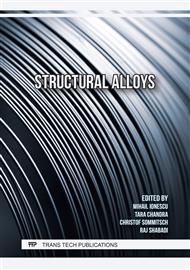p.121
p.129
p.137
p.143
p.149
p.157
p.163
p.169
p.177
On the Application of some Plasticity Laws
Abstract:
Three main rheological laws are found in the literature to describe the strain hardening of materials at high temperatures. The choice of the most suited law to describe a flow stress curve is often discussed as a function of the nature of the material; but it still remains difficult to choose the most appropriate one. These semi-empirical laws systematically comprise two main terms linked either to the dislocations generation or their annihilation.The objective of this paper is to determine by an inverse method which law appears to be the most suited. It is finally demonstrated that the application of one law is mostly equivalent to another. The various laws are overall equivalent and do not help to describe some peculiar physical mechanism of plasticity.
Info:
Periodical:
Pages:
163-168
Citation:
Online since:
December 2023
Price:
Сopyright:
© 2023 Trans Tech Publications Ltd. All Rights Reserved
Share:
Citation:



